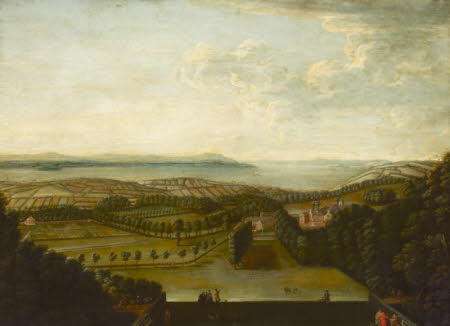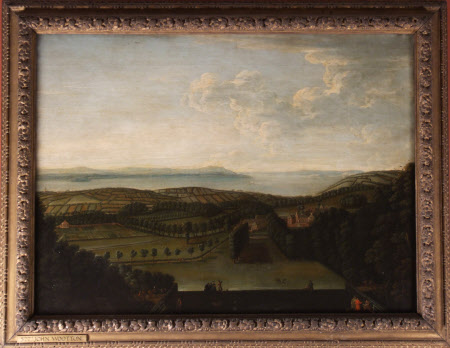Orchard Wyndham, Somerset
British (English) School
Category
Art / Oil paintings
Date
1700 - 1729
Materials
Oil on panel
Measurements
970 x 1320 mm
Place of origin
Somerset
Order this imageCollection
Petworth House and Park, West Sussex
NT 486817
Summary
Oil painting on canvas, Orchard Wyndham, Somerset, British (English) School, early 18th century. An extensive landscape. In the foreground are a terrace and figures with an avenue beyond leading to a fountain and stables. The house is to the right with hills and a river estuary in the distance. The view is northward and beyond the house is the town of Watchet and its harbour, historically part of the estate, on the Bristol Channel. Orchard Wyndham has descended through the Wyndham family for four centuries, since the early 16th century with Sir John Wyndham (died c. 1580), who had inherited it from his mother’s grandfather, Sir John Sydenham of Orchard, Somerset, via the Baronets from Sir William Wyndham, 1st Baronet (c.1632-1683) and the Earls of Egremont until George Francis Wyndham, 4th Earl of Egremont (1785–1845), who died without progeny, when it passed to William VI Wyndham (1834-1914) of Dinton House, Wiltshire (NT) and finally to William VII Wyndham (1868-1951). Orchard, the Somerset home of John Sydenham, whose daughter married Sir John Wyndham, Kt (d.1574) was afterwards called Orchard Wyndham. Orchard Wyndham, has been, the seat of the Wyndham family since the 16th century, and is situate near the church of the town of Williton. It is still occupied by the family. It encapsulates continuous building and alterations from the 14th to the 20th centuries, and has an exceptionally complicated plan. It is diffficult to reconstruct its architectural history, but the earliest part is the medieval north east side, and there is a considerable amount of Tudor work. There is a pseudo-Roman tombstone known as 'Mother Shipton's tomb' in the grounds. Mother Shipton (1488-c.1560) was a famous English witch who made a number of famous prophecies.
Provenance
In the collection of the 3rd Earl of Egremont (1751-1837) by 1835. Thence by descent, until the death in 1952 of the 3rd Lord Leconfield, who had given Petworth to the National Trust in 1947, and whose nephew and heir, John Wyndham, 6th Lord Leconfield and 1st Lord Egremont (1920-72) arranged for the acceptance of the major portion of the collections at Petworth in lieu of death duties (the first ever such arrangement) in 1956 by H.M.Treasury.
Credit line
Petworth House, The Egremont Collection (acquired in lieu of tax by HM Treasury in 1956 and subsequently transferred to the National Trust)
Makers and roles
British (English) School, artist previously catalogued as attributed to John Wootton (Snitterfield c.1682 – London 1764), artist

